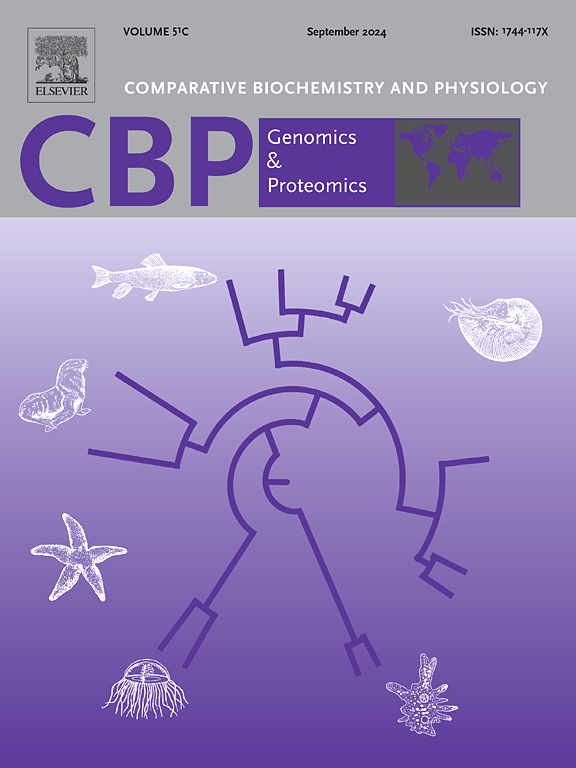Transcriptomic profiling reveals sex-specific gene expression patterns in Eriocheir sinensis gonads
IF 2.2
2区 生物学
Q4 BIOCHEMISTRY & MOLECULAR BIOLOGY
Comparative Biochemistry and Physiology D-Genomics & Proteomics
Pub Date : 2025-07-19
DOI:10.1016/j.cbd.2025.101584
引用次数: 0
Abstract
The Chinese mitten crab (Eriocheir sinensis) exhibits prominent sexual dimorphism with important economic implications, yet the molecular mechanisms underlying its sex determination and regulation remain poorly characterized. Here, we present the first comparative gonadal transcriptome analysis of E. sinensis to identify sex-related genes. High-throughput sequencing of testicular and ovarian tissues identified 5894 differentially expressed genes (DEGs), including 2581 female-related and 3313 male-related DEGs. Functional enrichment analyses revealed critical pathways governing crustacean sexual regulation, such as Steroid hormone biosynthesis pathway and GnRH signaling pathway. Moreover, a protein-protein interaction (PPI) network of 65 sexual regulation-related DEGs was constructed. Accordingly, Estradiol 17-beta-dehydrogenase 8 (HSD17B8), a dual-function enzyme in estrogen/testosterone metabolism, and Heat shock protein 90 (HSP90), a molecular chaperone stabilizing estrogen receptors, were identified as hub genes. In addition, experimental validation via RT-qPCR showed strong concordance with transcriptomic data, confirming the reliability of sex-biased expression patterns. The results of this study provide valuable resource of target genes for future studies on the molecular mechanisms underlying sex determination and regulation in E. sinensis.

转录组学分析揭示了中华绒螯蟹性腺性别特异性基因表达模式
中华绒螯蟹(Eriocheir sinensis)表现出突出的性别二态性,具有重要的经济意义,但其性别决定和调节的分子机制尚不清楚。在此,我们首次对中华按蚊的性腺转录组进行比较分析,以确定性别相关基因。对睾丸和卵巢组织进行高通量测序,鉴定出5894个差异表达基因(deg),其中女性相关deg 2581个,男性相关deg 3313个。功能富集分析揭示了甲壳类动物性调节的关键途径,如类固醇激素生物合成途径和GnRH信号通路。此外,我们还构建了一个由65个与性调节相关的deg组成的蛋白-蛋白相互作用(PPI)网络。据此,我们确定了参与雌激素/睾酮代谢的双功能酶Estradiol 17- β -脱氢酶8 (HSD17B8)和稳定雌激素受体的分子伴侣蛋白热休克蛋白90 (HSP90)作为枢纽基因。此外,通过RT-qPCR的实验验证显示与转录组学数据有很强的一致性,证实了性别偏倚表达模式的可靠性。本研究结果为进一步研究中华按蚊性别决定及其调控的分子机制提供了有价值的靶基因资源。
本文章由计算机程序翻译,如有差异,请以英文原文为准。
求助全文
约1分钟内获得全文
求助全文
来源期刊
CiteScore
5.10
自引率
3.30%
发文量
69
审稿时长
33 days
期刊介绍:
Comparative Biochemistry & Physiology (CBP) publishes papers in comparative, environmental and evolutionary physiology.
Part D: Genomics and Proteomics (CBPD), focuses on “omics” approaches to physiology, including comparative and functional genomics, metagenomics, transcriptomics, proteomics, metabolomics, and lipidomics. Most studies employ “omics” and/or system biology to test specific hypotheses about molecular and biochemical mechanisms underlying physiological responses to the environment. We encourage papers that address fundamental questions in comparative physiology and biochemistry rather than studies with a focus that is purely technical, methodological or descriptive in nature.

 求助内容:
求助内容: 应助结果提醒方式:
应助结果提醒方式:


